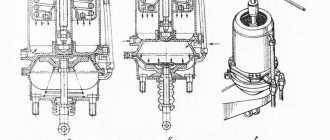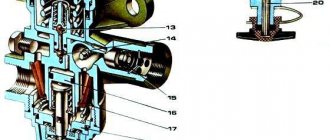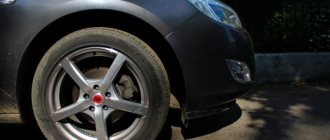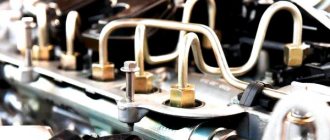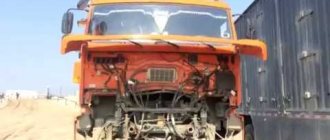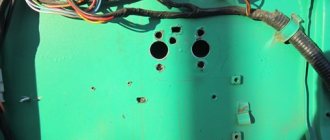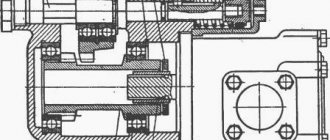see also
Comments 9
And what they say below is correct, the handbrake hisses as a result of something. My energach was working, but it didn’t overflow a bit. And the handbrake hissed
So my energy bypasses a little. I bought the handbrake valve half a year ago from China.
I would start by fixing the leaks and filling the cup with alcohol. And then in fact, either the handbrake will stop hissing, or you will look at the handle. But is it really the handle itself? And so the leaks still need to be cleaned up; in my city, it costs about 700 rubles to sort out an energach, which is quite a human sum. Good luck on the roads)
My accelerator valve had turned sour and the handbrake was hissing and wouldn’t work... though it wasn’t a Kamaz and it wasn’t running, but the system is roughly the same for everyone. The handbrake most likely has nothing to do with it. It just supplies air, it hisses only when the handbrake is put on - the accelerator valve is not installed and the air has nowhere to go and goes back.
Plus 1500. The problem is in the accelerator valve. Go through USK class. And because of its internal jambs, the atmospheric handbrake output hisses in the cabin for a long time. They installed a dehumidifier, but it was of little use. They drained it like this. A glass of brake fluid was poured into one of the “other” receivers through an unscrewed side plug. For a month, the dehumidification was normal and the pipes did not freeze
Then he would bleed off the murtsovka and finish off the fresh stuff with a large syringe.
The handle may have a head. Energachi is the same, protective valve, accelerating valve,
Since you have a KAMAZ system, installing a moisture separator is an extra cost, plus a filter costs money. On a ZIL with a KAMAZ system, there is a glass with a dipstick on the right side behind the cab; it is also called an “alcoholic”. Pour alcohol or a special liquid into it, and that’s it, you can only check it periodically in the receivers. But the water actually becomes less.
Change the faucet. On working KamAZ trucks I didn’t notice a difference with or without a water separator; anyway, I drain the water from the receivers once or twice a week. When I was working on the ZIL 45085, I didn’t even know what condensation was in the brake system (it had some kind of stray behind the right step that caught moisture and oil).
The handbrake valve is leaking, replace it or replace it with a repair kit.
Brake system malfunctions and ways to eliminate them
There are four main breakdowns that are associated with a malfunction of the KamAZ brake systems:
- interference with the safety valve;
- clogging in the receiver system or the formation of holes in the hoses;
- hole and loss of compressed air;
- The piston rings are out of order, the sensors are not functioning properly.
In order to timely identify and correct problems with the brakes of KamaAz, regular diagnostics of the operation of its systems, including electronics, are needed. It is recommended to perform it once every two years.
On the Internet you can find a detailed video with an analysis of all the errors. Below we will analyze them briefly, and also consider ways to eliminate them.
Excess oil inside the pneumatic system
The cause of the excess could be wear on the piston rings. It is necessary to urgently replace this part and signal all other work related to them. In models such as KamAZ 5320 and 6520, this problem can lead to serious problems within a short time after it occurs.
There is no air flowing into the receivers
The cause of the breakdown is most often that the pipes through which the air passes are clogged. To fix the problem, simply clean the pipes. On the KamAZ 5511 model, this problem often occurs due to a broken safety valve. In this case, it needs to be replaced.
Receivers in the pneumatic system are not filled quickly enough
There may be several reasons for this failure:
- the connecting elements are not secured well enough;
- the receiver is not secured tightly;
- the hoses through which air passes are damaged;
- The compressor is not operating at full capacity.
- tighten the connecting parts together more tightly; if necessary, they should be replaced;
- replace the receiver;
- repair or change hoses;
- diagnose the compressor if you need to replace it.
Incorrect pressure in receivers
This malfunction is typical for KamAZ 65115 and 43118. It is necessary to stabilize the regulator; if the breakdown occurs a second time, it should be replaced.
KamAZ does not brake when the brake pedal is pressed
The cause of this problem may be a compressed air leak; it must be found and repaired.
Reverse-acting pneumatic hand brake valve
Such a crane is used as a parking brake on vehicles of the KamAZ, ZIL, KrAZ, MAZ and Ural brands.
If there is a malfunction, the valve may leak air or the vehicle will slowly release the brakes. In this case, it will be necessary to replace the worn rubber o-rings and cuffs. This set is included in the RTI repair kit for the hand brake valve, has a catalog number 100-3537009-30 and the name “set of spare parts for the manual reverse-action brake valve”. The catalog number of the tap itself is 100-3537010.
Malfunctions of pneumatic drive power supplies
When servicing the pneumatic drive of the car brakes, you must first make sure that the system is tight. Particular attention should be paid to the tightness of connections of pipelines and flexible hoses, since this is where air leaks most often occur.
Places of strong air leakage are determined by ear, and weak ones - using a soap emulsion.
Air leaks from connections of pipelines and brake system devices are eliminated by tightening them, and leaking pipelines and flexible hoses are replaced. It must be remembered that on cars manufactured since March 1986, pipeline connections are sealed using rubber rings, so the tightening torques of the fittings should be less (Table 1).
If the air cylinders of the brake pneumatic drive are not filled and the pressure regulator vents air into the atmosphere, there may be several reasons:
— the pipeline between the regulator and the safety valves is blocked;
- the pressure regulator is faulty - most often the filter element in it is clogged with oil or ice crystals.
If the air tanks fill slowly and the air pressure does not reach the nominal pressure, then either the compressor or the pressure regulator is faulty. A malfunction of the compressor cylinder-piston group is also indicated by an increased oil content in the condensate.
Often the cylinders of a separate circuit are poorly filled. The air in each circuit of the brake system passes through a section of its “own” safety valve. Probably, the safety valve does not allow air into the cylinder or the air supply line to this circuit is clogged. It is also possible that the standard two-pointer pressure gauge is faulty.
Connecting a tap with an additional valve section.
- Output to the air cylinder.
- Atmospheric output.
- Additional valve control line output.
- Stub.
22. To get to the seals, remove the rubber boot.
23. Remove the retaining ring.
24. Remove the inner valve seat with the spring and sealing collar. 25. If it hisses from the boot side, change the sealing collar. To do this, use a 9 key to hold the inner seat by the edge, and use a 11 key to turn out the adjusting bolt head.
Parking brake features
In most KamAZ models, the additional braking system is combined with the main one. They have the same braking elements, as well as the same pneumatic drive. On the one hand, this significantly increases the efficiency of the mechanism, on the other hand, it reduces the level of safety. For example, if a separate unit of the main brake system fails, the parking brake system will also suffer. They are also characterized by similar types of breakdowns.
In these cars, this system is controlled using a corresponding mechanism - this is a pneumatic reverse-action handbrake valve. The device has a relatively simple design, which has a positive effect on its reliability and durability. The driver changes the position of the crane, as a result of which corresponding manipulations occur within the system aimed at connecting or disabling the parking brake.
Handbrake KamAZ connection diagram:
- When turned off, the valve lever is in the lower (lowered) position. Compressed air supplied from a suitable cylinder circulates freely throughout the system. The energy storage springs are compressed. Such a car is considered to be disengaged;
- When the brake is applied, the lever is moved to the uppermost position, in which it is fixed using a special latch. Such driver actions lead to the fact that compressed air from the line quickly escapes through the opening valves (this is accompanied by a characteristic noise and whistle). The springs of the energy accumulators expand, acting on the rear wheels of the vehicle;
In order to release the brakes, the driver should lift the lever slightly to remove it from the lock, and then lower it down until it reaches the extreme point. At this time, the valves close and compressed air from the cylinder is supplied to the line. All this leads to a sharp increase in pressure and forces the springs of energy accumulators to return to a compressed state.
How does the KamAZ brake system work?
The diagram and design of the brake system of a KamAZ vehicle includes such elements as:
- rear drum brake pad;
- cylindrical brake mechanism of the rear wheels;
- pedal;
- rod with piston part;
- tank for working fluid;
- main cylindrical mechanism and energy accumulators;
- front drum brake pad;
- wheel type cylinder;
- control lamp and pneumatic drive;
- forward pipeline;
- reverse pipeline.
The principle of operation of the brake system of a trailer, semi-trailer:
- When the user presses the brake pedal, an impulse is generated that is transmitted towards the vacuum booster mechanism.
- Through the amplifying element, the impulse is transmitted to the main cylindrical mechanism.
- The piston part of the system moves fuel to the wheel cylindrical parts, which increases the pressure in the brake type drive.
- The piston mechanism begins to move the pads to the disc clutch.
- Movement slows down. Fuel pressure can reach 11-16 MPa. The higher this indicator, the better the braking device works.
- When the user lowers the pedal, it returns to its initial position under the influence of spring parts.
Problem solving
Troubleshooting the handbrake on KamAZ must be approached in a comprehensive manner. Initially, you need to check the tightness of the system. To do this, the lever is first dismantled (it is attached to the bracket, it is easy to remove). Next, the pneumatic tubes are carefully disconnected, after which the valve cover is removed. The caps, plate, stem and other elements are also removed until the O-rings and cuff appear. Since these components are low cost, there is no need to check them for wear (if this is not noticeable visually) - simply install new ones, after which they are reassembled in the reverse order.
Problems with line depressurization require professional repair. It is strictly not recommended to resolve this issue on your own. If the air quickly escapes outward, this causes the springs of the energy accumulators to automatically fire, causing the machine to stop abruptly. In this case, it is necessary to use the emergency brake release system. New KamAZ models are equipped with an improved pneumatic brake drive, which allows the parking brake to be released immediately after starting the engine.
It is problematic to visually ensure that water or even condensation does not accumulate in the brake system. To avoid this problem, it is recommended to install a special dehumidifier that will remove moisture, preventing the risk of freezing during the cold season.
If a trailer is attached to the truck, it is necessary to first install an air distribution system, that is, expand the brake line. Otherwise, the parking brake will not apply to the towed equipment.
How to connect the handbrake on a KamAZ if for some reason there is not enough air in the line or the system mechanisms wear out? This is not only problematic, but also dangerous. Any malfunctions associated with the braking system, including the parking one, must be repaired immediately. This will increase the comfort of movement and its safety. You can work with brake mechanisms either independently or with the assistance of specialized specialists.
Certificate of Conformity No. ROSS RU.HA34.H00781. Brake system KAMAZ 65115 color diagram
The handbrake accelerator hisses on a KAMAZ
Why KamAZ slowly puts on the handbrake
Why KamAZ does not put on the handbrake and how to remove the emergency brake release
KAMAZ handbrake brake valve
How to improve the brakes on a Kamaz
KAMAZ accelerator valve
The brakes on an old-style KAMAZ take a long time to release
Moved the handbrake to a more convenient place
Adjusting Kamaz brakes
Table 12.2 - Possible malfunctions of brake systems
| Cause of malfunction | Remedy |
| 1. The pneumatic system receivers are not filled or are filled slowly. The pressure regulator does not work | |
| Damage to air supply hoses and tubes | Replace hoses and tubes |
| Insufficient tightening at the joints of tubes, hoses, connecting and transition fittings | Tighten connections Replace faulty connection parts and seals |
| The presence of nicks and dents on the end surfaces of the compressed air supply (discharge) bosses. Significant non-perpendicularity of the end surfaces relative to the axes of the threaded holes | Grind small nicks, dents, eliminate non-perpendicularity |
| Leakage of the receiver, device | Replace receiver, device |
| Reduced compressor performance | Check the compressor, replace if necessary |
| 2. The pressure regulator often operates when the pneumatic system is filled with air. | |
| Leakage of compressed air in the line from the pressure regulator to the safety valve | Eliminate the leak using the methods specified in paragraph 1 |
| 3. The pneumatic system receivers are not filled with air. The pressure regulator is activated | |
| Incorrect pressure regulator adjustment | Adjust the pressure regulator using the adjusting screw. If necessary, replace the regulator |
| Clogged tubes in the area from the pressure regulator to the safety valve | Inspect the tubes, if necessary, remove and blow out. If the tube is not bent correctly (there is a kink), replace it |
| 4. Receivers of circuits I, II or III are not filled with air | |
| Safety valve malfunction | Replace the faulty device |
| Clogged supply tubes | Blow out the tubes. If there are foreign objects in the tubes, remove them |
| 5. Trailer receivers are not filled with air | |
| Malfunction of trailer brake system control devices located on the tractor; trailer brakes | Replace the faulty device |
| Clogged supply tubes | Blow out the tubes If there are foreign objects in the tubes, remove them |
| 6. The pressure in the receivers of circuits I and II is higher or lower than normal when the pressure regulator is working | |
| Malfunction of two-pointer pressure gauge | Replace pressure gauge |
| Incorrect pressure regulator adjustment | Adjust the regulator using the adjusting screw. If necessary, replace the regulator |
| 7. Ineffective braking or lack of braking of the vehicle by the working brake system when the pedal is fully depressed | |
| Brake valve malfunction | Replace brake valve |
| Contamination of the cavity under the lever covers of the two-section brake valve. Rupture or removal of covers from the seat | Clean the cavities from dirt. Replace covers if they are unsuitable |
| Relay valve malfunction | Replace the relay valve |
| Significant leakage of compressed air in the lines of circuits I and II in the area after the brake valve | Eliminate the leak using the methods specified in paragraph 1 |
| Improper adjustment of the brake valve | Adjust the brake valve |
| Exceeding the permissible stroke of the brake chamber rods | Adjust the stroke of the rods |
| Moisture on brake linings | Dry the brake mechanisms with several brakes. |
| Jamming of expansion fist shafts | Clean and lubricate the expansion knuckle shaft bushings |
| Brake lining wear | Replace |
| 8. Ineffective braking or lack of braking of the vehicle by the parking brake system | |
| Accelerator valve malfunction; parking brake control valve | Replace faulty devices |
| Clogged tubes or hoses of circuit III | Clean the tubes and blow them out with compressed air. If necessary, replace them with serviceable ones. |
| Malfunction of spring energy accumulators | Replace a faulty brake chamber with a spring energy accumulator |
| Exceeding the permissible stroke of the brake chamber rods | Adjust the stroke of the rods |
| 9. When installing the parking brake system control valve handle in a horizontal position, the car does not release the brakes | |
| Air leakage from the tubes of circuit III, from the atmospheric outlet of the accelerator valve | Eliminate the leak using the methods specified in paragraph 1 |
| Failure of the spring energy accumulator | Replace a faulty brake chamber with a spring energy accumulator |
| Jamming of expansion fist shafts | Lubricate the shaft bushings |
| 10. When the vehicle is moving, the rear trolley is braked without actuating the brake pedal and the parking brake system control valve. | |
| Malfunction of two-section brake valve | Replace faucet |
| Incorrect brake valve adjustment | Adjust the tap |
| Failure of the seal between the cavity of the energy accumulator and the working chamber of the spring | Replace a faulty brake chamber with a spring energy accumulator |
| 11. Ineffective trailer braking or lack of braking when the brake pedal is pressed or the parking brake system control valve is turned on | |
| Compressed air leak | Eliminate the leak using the methods specified in paragraph 1 |
| Malfunction of the following drive devices: single safety valve, trailer brake control valve with a single-line drive, trailer brake control valve with a two-line drive, connecting heads, line filters, combined trailer brake air distributor | Replace faulty devices |
| Exceeding the permissible stroke of the trailer brake chamber rods | Adjust the stroke of the rods |
| Brake chamber membrane rupture | Replace membrane |
| 12. The brake mechanisms do not release when the trailer brake release valve button is pulled out | |
| Malfunction of the trailer brake release valve | replace the faucet |
| 13. When you press the brake pedal when actuating the parking brake system control valve, the brake lights do not light up | |
| Malfunction of the brake signal switches or pneumatic drive devices | Replace faulty switches or devices |
| 14. Presence of a significant amount of oil in the pneumatic system | |
| Compressor piston ring wear | Replace compressor |
| 15. When braking, the car pulls to the side | |
| The adjustment of the brake mechanisms is disturbed | Adjust the output of the rods |
| Oiling of brake pad linings of individual brake mechanisms | Wash the pads or replace them |
